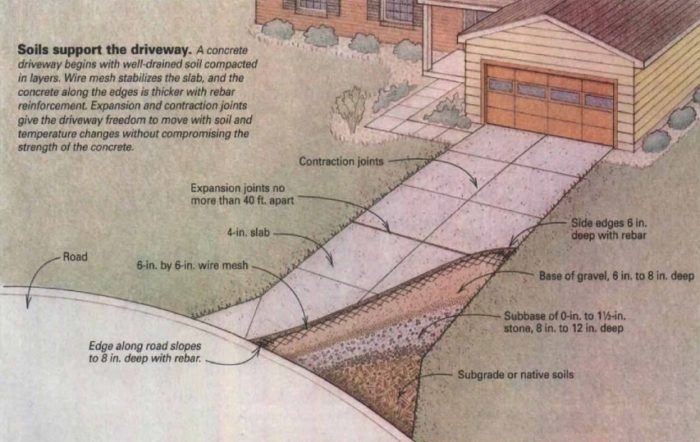Placing a Concrete Driveway
Careful preparation of the soils and proper positioning of joints and reinforcement are keys to a driveway that lasts a lifetime.

Synopsis: Concrete is an attractive and durable driveway alternative to asphalt. The author, a concrete contractor, explains the process, from preparation of the sub-base to the final broom finish that gives the surface traction.
A few years back, we had just finished a driveway at a house in South Bend, Indiana. We were about to call it a day when the homeowners’ dog got loose, burst into the garage and used our freshly placed concrete drive as his escape route. When the dog heard us holler, he stopped in the middle of the driveway. Then we tried to get him back inside, which made him scamper back and forth on top of the concrete, making a bad situation worse. We ended up refinishing the whole driveway and giving that dog a scrubbing he’ll never forget.
A driveway is only as good as the soils beneath it
We’ve been putting in concrete driveways for 30 years, and a crucial part of proper driveway design is making sure the materials below the concrete are adequate. The first 6 in. to 8 in. of material directly below the concrete is the base. The subbase is the soil 8 in. to 12 in. below the base, and the subgrade is usually the native or naturally occurring soil below the subbase. The design thickness of each layer depends on the soil being built on. Acceptable natural soils such as sand and gravel let moisture drain. If the subgrade consists of this type of soil, then it can be compacted to serve as the base and subbase, and more excavating and filling are unnecessary.
However, if the subgrade is clay, peat or fine grained silty soil that holds moisture and drains poorly, removal of up to 20 in. of subgrade soil might be necessary, depending on the support value of the soil. If you have doubts about the soil characteristics in your case, it’s worth hiring a soils engineer to do an evaluation.
Establish driveway elevations early for proper drainage
Prior to excavating and backfilling, the exact elevation of the top of the drive should be established. Then, as earthwork is being done, base grades can be brought up with equipment usually to within an inch of their required height, which saves on hand-grading later. For the best drainage, we try to drop the driveway at least in. per running foot away from the house.
Some situations prevent proper drainage, such as an area of concrete that is locked between a house and a garage. In these cases a catch basin may have to be installed as part of the driveway’s drainage system.
The best way to remove water from a catch basin is to use a drain pipe at least 4 in. in dia. that returns to daylight or to a storm sewer that is located safely away from the house. A second method is connecting the catch basin to a dry well. In the most extreme cases, a sump pump is installed to pump collected water to a safe place. The last solution is the most costly and probably should be used only with the recommendation of an engineer.
For more photos, drawings, and details, click the View PDF button below:






















